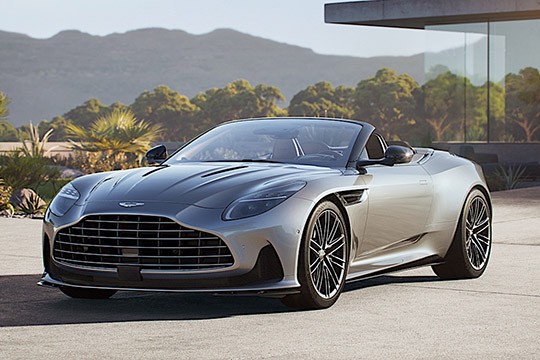ASTON MARTIN DB12 Volante Models/Series Timeline, Specifications & Photos
First production year: 2023
Engines: Gasoline
Body style: Convertible (spider/spyder, cabrio/cabriolet, drop/open/soft top)
After creating the first so-called super-tourer, Aston Martin came up with the drop-top version traditionally named "Volante." The British car manufacturer didn't want to just cut the roof off and call it a day. It went even further and refined the entire experience of driving a grand tourer with supercar abilities and created a luxurious, British-style, two-door vehicle that could go blistering fast and challenge supercars on a track or on a winding road. But, unlike those go-fast vehicles, the Aston Martin DB12 Volante was able to pamper its users with second-to-none cabins and comfortable driving experiences at any speed.
The British automaker was blooming, and its cars became more appealing after years of Ford's dominance. It could finally choose the engines and transmissions it wanted, not the same powerplants as in a Crown Victoria with some gimmicks added on top. But, most importantly, designers could create gorgeous vehicles without using Ford Focus blinkers or sharing the same parts bins as mundane cars. As a result, the DB12 Volante boasted a front fascia dominated by the massive wide grille that resembled the same shell shape as the former DB2 or other famous Aston Martin cars. Despite the general trend of creating slim headlights, the British designer Marek Reichman followed the same design language of Aston Martin cars and created swept-back headlamps with rounded edges. On the sides, he made the extracting vents for the front wheel arches on the upper side of the fenders, thus incorporating them into the car's overall design language. Like the coupe, the convertible version of the DB12 featured a raked windscreen extended almost above the middle section of the front seats. The rear fenders were curved and featured wide shoulders over the wheels. Finally, at the back, the short deck covered a trunk large enough to fit two persons' luggage for a weekend and, under the rear bumper, two wide oval exhausts poked through, being underlined by the massive diffuser. To keep the tradition alive, Aston Martin ditched the idea of installing a retractable metallic roof and placed a three-layer rag top that muted most of the ambiance sounds.
Inside, Aston Martin created a combination of leather, aluminum, real wood, and touchscreens, creating a luxurious ambiance. To keep the grand tourer attribute alive, the automaker kept the four-seat solution, even though the rear ones were more suitable for small-sized dogs or some bags. Nevertheless, those seats were treated with the same respect, covered in leather, and featured elegant hand-stitching elements.
Under the hood, the AMG-sourced twin-turbo V8 pumped out a healthy dose of power. Even if the world was dominated by electrified vehicles, Aston Martin offered its customers a super-tourer without any electrification help. As a result, the spark-ignited powerplant offered 671 HP (680 PS) mated to an eight-speed automatic transmission. It is worth mentioning that it was a traditional torque-converter type, not a dual-clutch one. Even though these types of gearboxes provided smoother gear changes, essential for a luxurious grand tourer such as the DB12, with or without a fixed roof on top.
